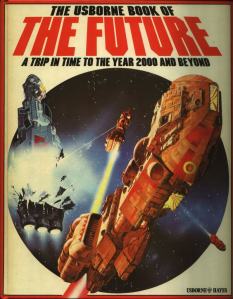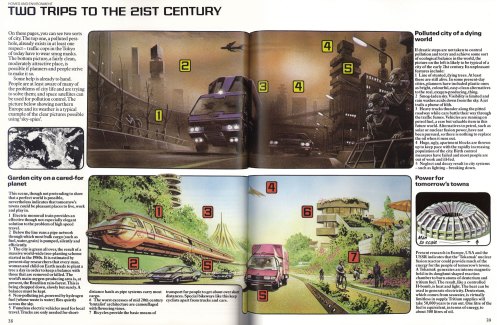Many of us grew up in thinking that we knew what ‘the future’ was going to be like.
If you were a child of the 60s or 70s your vision of the future was probably one of flying cars, endless leisure time and food tablets that could provide all of your nutrition in an instant. The future was always the year 2000 and everything that came after that. Most of our images of the future were either of this luxurious, leisured lifestyle, or one shaped by films and comics. In the late 70s, one comic book, 2000AD, brought an alternative future of atomic war wastelands and robotic warriors.
My favourite book as a kid back in 1979 was the Usbourne Book of the Future.
The page that really got me was of a projection of the year 2000. It had two different scenarios, one positive, and one negative.
The negative picture portrayed a decaying world filled with pollution (this is pre-global warming), dead trees, overpopulation and an environment which had reached its limits. On the other hand, the positive picture showed a world with bright blue skies, abundant green vegetation, clean electric transport systems, smart urban design and happy, healthy people. Not surprisingly, the second image was the one that I hoped the year 2000 would be like, but the first image was the one that scared me.
Now in 2012, the future might look a bit like the past. Less energy, yes, but what else? Energy descent as a concept is very simple on the surface, but when you start painting a scenario, all sorts of questions get flung about. In Peak Everything, Richard Heinberg suggests we could be looking at a messy collapse at the most pessimistic level or an ‘intelligent’ descent on the more optimistic. Many of us can visualise the collapse scenario because we’ve been conditioned by Hollywood through countless films of a future dystopia: 2012, The Day After Tomorrow, Mad Max, Terminator, Planet of the Apes, Idiocracy, WALL – E . . . the list goes on.
What we seem to have more trouble with is the intelligent, planned transition vision. When I have run workshops to visualise this type of future, a lot of people have tended to be unable to really tune into a positive vision (maybe it was me!) or struggled with it. But, what an energy descent future could look like is tricky. Nine million farmers? Community supported agriculture? Millions working from home? Massive levels of microgeneration for wind and solar energy? Do we keep the internet? Ipods? An economy based on salvaging the scraps of the present? The end of globalisation? Arts & crafts? Horse-drawn transport? Weaving? What do roads look like in 2040?
There is almost an infinite number of questions that could be asked about a post-oil future, and as we know, predicting the future is fraught with problems. The other thing is that for a child of the 60s, reared on 70s sci-fi about the ‘YEAR 2000’ (and beyond), the future is already here. Not quite as set out in old comics and books, but look at where we are: climate change, peak oil, globalisation, the internet, biofuels, economic meltdown. None of that was in 2000AD comic in 1978!
On another level, of course, the future is an illusion. It never comes, because when you get there it’s now/today . . . So, where are we going with this? Well, I’ve got a wish list of things I’d like to see happen:
- Develop a vision of what positive transition to a post-peak world/West Sussex (where I live) could be like. Even down to the little details.
- Realise that today/now is the only opportunity we ever have to do anything in, and we can’t just live in hope that the future will magically solve all these issues. The future doesn’t exist!
- Encourage cartoonists and writers of sci-fi to come up with a new comic which deals with an energy descent future, warts and all!
- Sign out and cook some dinner. I am planning ahead.


